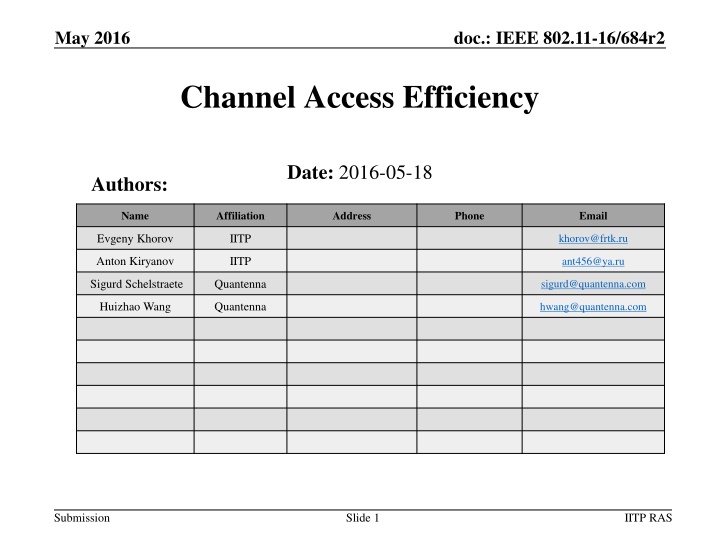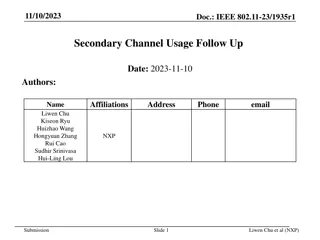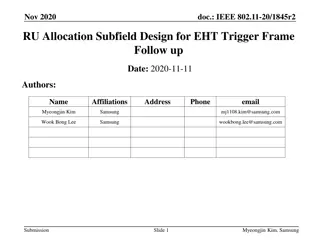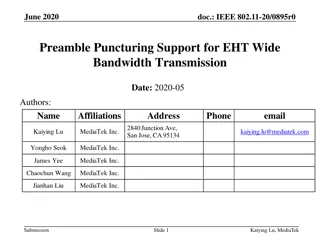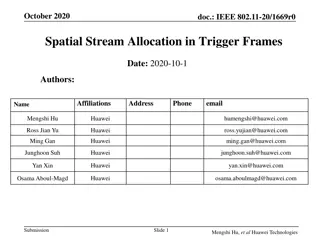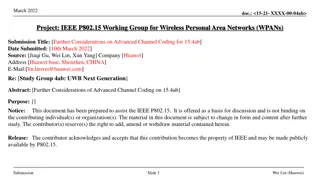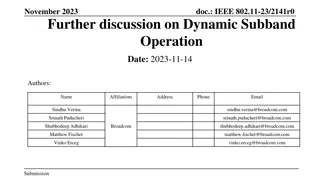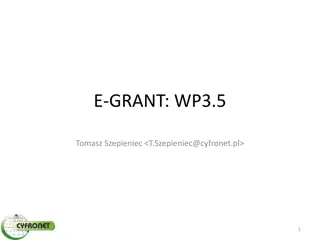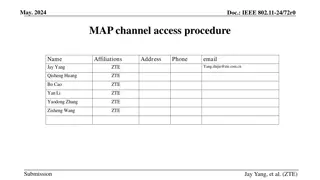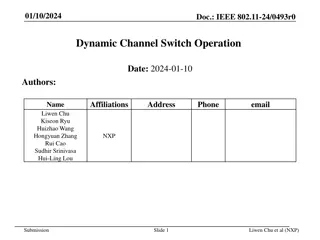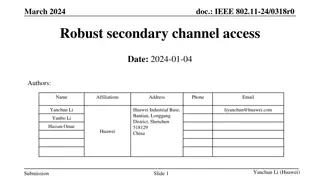Efficient Channel Resource Allocation in IEEE 802.11 Networks
This document discusses the efficiency of different channel access methods in IEEE 802.11 networks, comparing DCF (EDCA) with Trigger-based allocation for UL RUs. It explores scenarios, performance results, and parameter settings to determine the most efficient resource allocation approach.
Download Presentation

Please find below an Image/Link to download the presentation.
The content on the website is provided AS IS for your information and personal use only. It may not be sold, licensed, or shared on other websites without obtaining consent from the author.If you encounter any issues during the download, it is possible that the publisher has removed the file from their server.
You are allowed to download the files provided on this website for personal or commercial use, subject to the condition that they are used lawfully. All files are the property of their respective owners.
The content on the website is provided AS IS for your information and personal use only. It may not be sold, licensed, or shared on other websites without obtaining consent from the author.
E N D
Presentation Transcript
May 2016 doc.: IEEE 802.11-16/684r2 Channel Access Efficiency Date: 2016-05-18 Authors: Name Affiliation Address Phone Email Evgeny Khorov IITP khorov@frtk.ru Anton Kiryanov IITP ant456@ya.ru Sigurd Schelstraete Quantenna sigurd@quantenna.com Huizhao Wang Quantenna hwang@quantenna.com Submission Slide 1 IITP RAS
May 2016 doc.: IEEE 802.11-16/684r2 Background Trigger frames can schedule UL RUs for both deterministic and random channel access. To send a Trigger frame, an AP shall contend for the channel with associated STAs and STAs from other BSSs. When the AP wins the contention, it allocates RUs for the STAs. However, when STAs use DCF (or EDCA), collision probability increases. When the STAs which are given RUs for deterministic access try to send frames in RUs for RA, the contention increases. What is the most efficient way to allocate channel resource: DCF (EDCA) or Trigger-based? Submission Slide 2 IITP RAS
May 2016 doc.: IEEE 802.11-16/684r2 Scenario Description N STAs All nodes are in the RX range of each other AP No hidden STAs We consider 4 channel access methods 1. DCF without RTS/CTS 2. DCF with RTS/CTS 3. Trigger-based Random Access without RTS/CTS 4. Trigger-based Deterministic Access without RTS/CTS In 3 and 4, the STAs can also try to send frames with DCF Submission Slide 3 IITP RAS
May 2016 doc.: IEEE 802.11-16/684r2 Trigger-based Random Access without RTS/CTS Trigger for Random Access Trigger for Random Access M-STA BlockACK Data Collision Empty 26 26 20 MHz .. 26 26 26 26 Success .. 20 MHz 26 26 26 26 .. 20 MHz 26 26 26 26 .. 20 MHz 26 26 Collisions and empty RU are possible! SIFS SIFS DIFS+ backoff Submission Slide 4 IITP RAS
May 2016 doc.: IEEE 802.11-16/684r2 Trigger-based Deterministic Access without RTS/CTS N=37 STAs M-STA BlockACK Trigger Data Trigger 26 26 20 MHz .. 26 26 26 26 .. 20 MHz 26 26 26 26 .. 20 MHz 26 26 26 26 ... .. 20 MHz 26 26 No collisions, no empty RUs! SIFS SIFS DIFS+ backoff Submission Slide 5 IITP RAS
May 2016 doc.: IEEE 802.11-16/684r2 Scenario Parameters Parameter Value Channel width 80 MHz Control frame MCS MCS0 Data frame MCS MCS5 (272 Mbps @80 MHz) MSDU size 1500 byte Data frame 1 MSDU 24 MSDUs Traffic mode Saturated Submission Slide 6 IITP RAS
May 2016 doc.: IEEE 802.11-16/684r2 Results (24 MSDUs) Throughput Mbps 300.00 250.00 #RUs = N * 200.00 150.00 DCF DCF with RTS/CTS Trigger Deterministic Trigger Deterministic + DCF Trigger Deterministic + DCF with RTS/CTS Trigger RA Trigger RA + DCF Trigger RA + DCF RTS/CTS Trigger RA #RU=4 #RUs = N = OCW 100.00 RU ~4.5ms 50.00 0.00 0 2 4 6 8 10 12 14 16 Number of STAs * For Trigger Based Deterministic Access the throughput depends on the # RUs. For long frames, Trigger-based Random access provides low performance, while Trigger-based Deterministic access gives the highest throughput Slide 7 Submission IITP RAS
May 2016 doc.: IEEE 802.11-16/684r2 Results (1 MSDU) Throughput Mbps DCF DCF with RTS/CTS Trigger Deterministic Trigger Deterministic + DCF Trigger Deterministic + DCF with RTS/CTS Trigger RA Trigger RA + DCF Trigger RA + DCF RTS/CTS 250.00 200.00 RU ~2ms 150.00 100.00 50.00 0.00 0 5 10 15 20 25 30 35 Number of STAs DCF provides the lowest performance because of relatively long headers, etc. Trigger-based Deterministic access shows the best performance. Trigger based Deterministic Access suffers from STAs which use DCF Submission Slide 8 IITP RAS
May 2016 doc.: IEEE 802.11-16/684r2 Remarks Since the cumulative UL throughput degrades when STAs use Trigger-based random access/DCF/EDCA, it makes sense to improve efficiency of the channel access by using deterministic Trigger-based channel access instead of Trigger-based Random Access/DCF/EDCA. If STAs are not getting scheduled for a long time, they should have an option to use EDCA/Trigger-based RA as usual. Submission Slide 9 IITP RAS
May 2016 doc.: IEEE 802.11-16/684r2 Option 1. Limiting EDCA Usage Those STAs which obtain scheduled RUs should have lower priority when access the channel with EDCA than the STAs which do not obtained RUs in Trigger-frames. Currently in a BSS there can be only one set of EDCA parameters, which are broadcast in beacons. We propose to use another set of EDCA parameters for those STAs which are granted scheduled RUs in the Trigger frames. By increasing CWmin and AIFSN, the AP can limit EDCA usage by these STAs, and thus reduce contention. At the same time, the STAs which are not granted RUs for some time, may have higher priority to access the channel, and thus to notify the AP that they have traffic. Which set of EDCA parameters shall be used is TBD. It can be defined by the AP explicitly or by the protocol rules, e.g. based on some timeout during which the STA obtains/does not obtain RUs. Submission Slide 10 IITP RAS
May 2016 doc.: IEEE 802.11-16/684r2 Option 2. Limiting Trigger-based RA usage Changing EDCA parameters is not enough: They are applicable only for EDCA, not Trigger-based RA. We propose to use similar approach, i.e. to define additional OCWmin for the STAs which have RUs in previous Trigger frames. Submission Slide 11 IITP RAS
May 2016 doc.: IEEE 802.11-16/684r2 Conclusion In this presentation, we show that the usage of DCF, EDCA and Trigger-based random access by all STAs (including those which are given dedicated RUs by Trigger frames) decreases performance of the network. We propose adding a mechanism that allows the AP to configure the usage of EDCA and Trigger-based random access by associated STAs which obtain RUs for transmission. Submission Slide 12 IITP RAS
May 2016 doc.: IEEE 802.11-16/684r2 Straw Poll #1 Do you agree to add the following text in SFD? x.y.z The spec shall define a mechanism that allows an AP to assign another set of EDCA parameters to STAs being scheduled by the AP. Note: For example, these STAs can be the STAs which were scheduled recently during some time interval or the STAs explicitly listed by the AP. Y N A Submission Slide 13 IITP RAS
May 2016 doc.: IEEE 802.11-16/684r2 Straw Poll #2 Do you agree to add the following text in SFD? x.y.z The spec shall define a mechanism that allows an AP to assign another OCWmin to STAs being scheduled by the AP. Note: For example, these STAs can be the STAs which were scheduled recently during some time interval or the STAs explicitly listed by the AP. Y N A Submission Slide 14 IITP RAS
